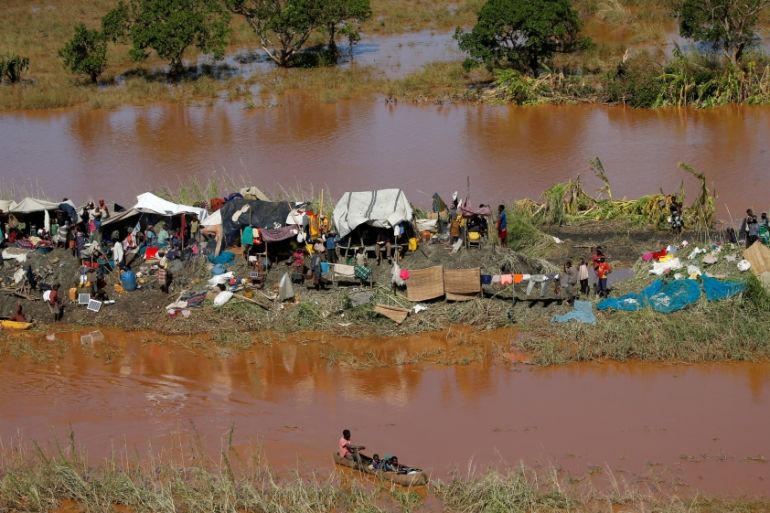Property damaged as Cyclone Eloise hits Mozambique’s Beira
Cyclone Eloise, which lost its strength, hit the port city of Beira early on Saturday, but danger of flooding remains.

Tropical Cyclone Eloise has made landfall near Mozambique’s port city of Beira, which was devastated by Cyclone Idai less than two years ago.
“Beira had mild damage, but is too early to quantify the extent and scale of destruction,” Luisa Meque, president of Mozambique’s National Institute for Disaster Risk Management and Reduction (INGD), said in a television interview with national broadcaster TVM on Saturday.
Keep reading
list of 3 itemsCyclone Idai: Thousands still struggling to cope
Death toll from devastating Cyclone Idai rises above 1,000
The South African weather department said Eloise made landfall around 2:30am, with wind speeds of 160 kilometres (99 miles) per hour. The cyclone has since lost its strength and has been downgraded to a tropical storm, according to the World Meteorological Organization (WMO).
More from #Beira #Mozambique before #CycloneEloise made landfall. Flooding is expected to continue for the 72 hours. pic.twitter.com/WCOCWEJGJg
— Fahmida Miller (@FahmidaMiller) January 23, 2021
Cars were submerged in water, walls of some low-lying buildings collapsed and swaths of land were flooded in Beira, posts on Twitter showed.
Beira was the epicentre of damage from Idai in March 2019, which ravaged the country’s second biggest city and killed more than 1,000 people across Mozambique, Malawi and Zimbabwe.
Al Jazeera’s Fahmida Miller, reporting from Johannesburg, said the area affected is one where “people live in informal settlements, homes made from plastic sheeting [and] corrugated iron”.
“It appears that hundreds of these homes have been destroyed by the cyclone, and those people are still looking for shelter in places like schools,” Miller said.
She added that there is concern as flooding is expected to continue over the next 72 hours, adding that areas outside of Beira have also been heavily affected.
“Aid agencies can’t get out … there’s a lot of concern around the capacity of the aid agencies as well as the government to help people.”
Mozambique National Institute of Meteorology (INAM) said Sofala province, which includes Beira, had seen 200mm (8 inches) of rainfall and was likely to see another 100mm of rain over the next 24 hours.
Power supplies were shut down as the cyclone damaged power lines and uprooted some electricity poles, power utility EDM said, local digital news media A Carta reported.
“The cyclone is still in the territory of Mozambique and should make an exit at 8pm today,” Gorkhmaz Huseynov, head of the Mozambique delegation of the International Federation of Red Cross, told Reuters news agency.
WMO late on Friday had upgraded the storm, fuelled by the warm Indian Ocean waters of the Mozambique channel, to a tropical cyclone with strength equivalent to a category two storm. Category two strength – on a five-level scale – refers to hurricanes with maximum wind speeds of 154-177 kph.
“By tomorrow, it will be an overland tropical depression. At that time the speed will be 60kph,” Mbazhi Maliage, a forecaster at the South African Weather Service, told Reuters.
The weather department said on its official Twitter handle that more than 200mm of rainfall was expected from Saturday night to Monday in some parts of South Africa’s Mpumalanga and Kwa-Zulu Natal provinces and in the southern African kingdom of eSwatini.
⚠️🌀ELOISE is expected to reach Tropical Cyclone status and make landfall near Beira in Mozambique. It is then expected to become an overland depression and result in significant rain over eastern parts of SA. Have a look at the alert areas below. pic.twitter.com/zSvbnATpiz
— SA Weather Service (@SAWeatherServic) January 22, 2021
Ahead of the cyclone’s arrival, the International Federation of Red Cross and Red Crescent Societies warned that at least 100,000 people will be affected.
“Heavy rainfall will persist for over 24 hours,” it said. “The amount of rain will be sufficient to flood low areas of Beira and Buzi. Further flooding may arrive some days later as accumulated water flows down the Pungue and Buzi rivers from Zimbabwe.”